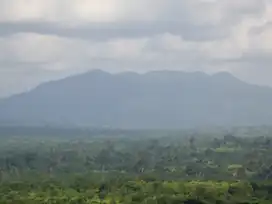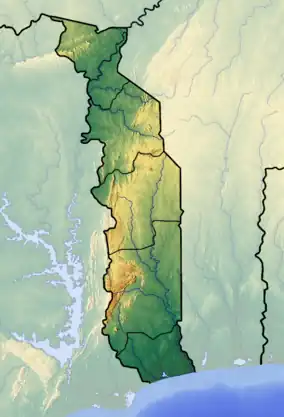| Mount Agou | |
|---|---|
 | |
| Highest point | |
| Elevation | 986 m (3,235 ft) |
| Prominence | 757 m (2,484 ft) |
| Listing | Country high point |
| Coordinates | 6°52′N 0°45′E / 6.867°N 0.750°E[1] |
| Geography | |
 Mount Agou Location of Mount Agou in Togo | |
| Location | Plateaux Region, Togo |
Mount Agou (French: Mont Agou, earlier known as Baumannspitze or Baumann Peak) is the highest mountain in Togo at 986 metres (3,235 ft). It is situated to the south east of Kpalimé in the Plateaux Region of Togo. The mountain lies close to the border with Ghana; this country can be seen from the summit.
Geology
Mount Agou is part of an extreme western outlier of the Atakora Mountains that cross neighbouring Benin.[2] Within the Togolese borders, this range is sometimes called the Togo Mountains. Together with these mountains, Mount Agou forms part of the Dahomeyide Orogen, an area that was uplifted in an orogenic process when the West African Craton bumped into the Benin-Nigerian Shield. The internal suture zone of this belt contains several isolated massifs that are oriented in North-South direction. Mount Agou is part of one of these massifs which, depending on the scientific classification, is either called the Lato-Agou Massif (together with nearby Lato Hill) or the Ahito-Agou Massif (together with Mount Ahito).[3][4][5]
Although geologically part of these structures, Mount Agou presents itself as an inselberg, rising abruptly above the relatively flat Danyi Plateau with a drop of around 700 metres (2,300 ft).[6] It stands on a base of charnockitic igneous rock from the Neoproterozoic Era. The mountain itself is mainly made up of amphibolite, pyroxenites and gabbro,[7] and contains deposits of bauxite.[8][9]
History
Historically, the region is inhabited by Ewe people. In the late seventeenth and early eighteenth century, Adangme refugees settled at Mount Agou, fleeing from slave traders.[10] In 1870, Ashanti troops tried to subdue the area, but were pushed back by the villages on the mountain. For this reason, the mountain is still seen as a symbol of resistance.[11]
In times of the German protectorate Togoland, the mountain was called Baumann Peak (Baumannspitze), named after geographer Oscar Baumann.[12] A mythical narration tells that when the Germans arrived in nearby Naviè village, they made an agreement to buy what can fit into a sheepskin. They then cut a skin in pieces and surrounded the mountain with them. This story is similar to the traditional tale of the foundation of Carthage by Dido.[11]
Near the top of Mount Agou, the remains of military installations from both the German era and from French Togoland can be seen. These include a French military hospital from World War II. Memorial stones have been laid on the mountain that refer to these periods.
In 1955, the cacao swollen shoot virus entered Togo from Ghana through the cocoa fields around Mount Agou. A particularly virulant variant of the virus was called "Agou 1".[13]
In the 2000s there were plans for commercial exploitation of the bauxite deposits on the mountain, which were met with protests from local environmental organisations.[11] In the present day, the summit area is used for communications; the equipment includes an antenna on the mountain top.
Tourism
The slopes are lined with several villages and with cocoa and coffee fields that are interspersed with banana plants and other fruit trees. There is a paved road to the top that can be travelled by motorbike or car. Most tourists however prefer to take the unpaved foothpaths that are used by the local population to commute between the villages and to the fields. These paths cross several streams, and pass by a waterfall. Depending on where one leaves the paved road, the walk to the summit can take from a few minutes to up to 3 hours. There are several check points in the area, and local authorities charge a fee from tourists wishing to climb the mountain.
Occasionally, a full marathon is organised under auspices of the Togo Leading Athletics Association that includes a climb to the top of Mount Agou.[14]
Flora and fauna
The mountain and the surrounding areas were densely covered with rainforest in the past, with strong biological connections from Mount Agou to the rest of the Atakora chain. Starting from the second half of the twentieth century, strong deforestation has taken place for logging and agriculture, associated with considerable biodiversity loss, leaving only patches of original forest on isolated spots along the mountain slopes.[15] Nevertheless, biological research has been done, for example on butterflies (Heliconiinae,[16] Papilionoidea, Hesperioidea[15]) and on Pteridophytes.[17]
Cultural references
An exoplanet (planet orbiting another star) has the name Agouto, which is derived from Mount Agou. It circles the star WASP-64 at a distance of 1200 lightyears in the constellation of Canis Major It received its name from Togolese amateur astronomers in the NameExoWorlds contest of 2019, organised by the International Astronomical Union.[18]
References
- ↑ "Mont Agou" on Peakbagger.com Retrieved 2 October 2011
- ↑ "Mount Agou (mountain, Togo)" on eb.com Retrieved 2 October 2011
- ↑ Affaton, P., Kröner, A., Seddoh, K.F. (2000) "Pan-African granulite formation in the Kabye Massif of northern Togo (West Africa): Pb-Pb zircon ages" Int Journ Earth Sciences 88 pp.778–790
- ↑ Tairou, M.S. et al (2012) "The Aledjo Quartzitic Ruins in Northern Togo: Genesis and Structural Geomorphology" Global Journal of Geological Sciences Vol.10 No.2
- ↑ Tairou, M.S., Affaton, P. (2013) "Structural Organization and Tectono-Metamorphic Evolution of the Pan-African Suture Zone: Case of the Kabye and Kpaza Massifs in the Dahomeyide Orogen in Northern Togo (West Africa)" International Journal of Geosciences Vol.4 No.1
- ↑ Bocquier, G. et al (1977) "Interprétation pédologique des dépressions annulaires entourant certains inselbergs" Sciences Géologiques, bulletins et mémoires 30-4 pp.245–253
- ↑ Gsell, A., Charrier, J. (1952) "Observations sur la chromite du mont Ahito (Togo)" Bulletin de la Société Géologique de France S6-VIII (3): pp.207–212
- ↑ Markwitz, V. et al (2016) "Metallogenic portfolio of the West Africa craton" Ore Geology Reviews 78 pp.558–563
- ↑ Markwitz, V., Hein, K.A.A., Miller, J. (2016) "Compilation of West African mineral deposits: Spatial distribution and mineral endowment" Precambrian Research 274 pp.61–81
- ↑ Strickrodt, S. (2015) Afro-European Trade in the Atlantic World: The Western Slave Coast, c1550-c1885. Woodbridge: James Currey
- 1 2 3 Gardini, M. (2013) "Land and Conflicts in Togo" PhD thesis, University of Milano-Bicocca
- ↑ Mount Agou | mountain, Togo Encyclopaedia Britannica
- ↑ Cilas, C., Dufour, B., Djiekpor, E.K. (1988) "Étude de la résistance au swollen shoot du cacaoyer (Theobroma Cacao L.) dans un diallèle quasi complet 8 x 8" Café Cacao Thé Vol.32 N.2 pp.105–110
- ↑ 2nd Trail-Marathon du Mt. Agou, Kpalimé, Togo African Marathon Challenge
- 1 2 Sáfián, S., Csontos, G., Kormos B. (2009) "Butterfly (Lepidoptera: Papilionoidea & Hesperioidea) records from Mount Agou and Klouto (Kouma-Konda Region, near Kpalimé), Togo Mountains, Togo (with notes on species composition in highly degraded forest habitats)" Metamorphosis Vol.20 No.4 pp.115–130
- ↑ Coache, A. (2014) "Primière citation de Acraea (Actinote) acerata Hewitson, 1874 et synthèse du genre en République Togolaise (Lepidoptera Nymphalidae, Heliconiinae)" Bull. mens. Soc. linn. Lyon 83(5–6), pp.111–115
- ↑ Abotsi, K.E. et al (2018) "A first checklist of the Pteridophytes of Togo (West Africa)" Biodivers Data J. (6)
- ↑ Togo Approved Names International Astronomical Union